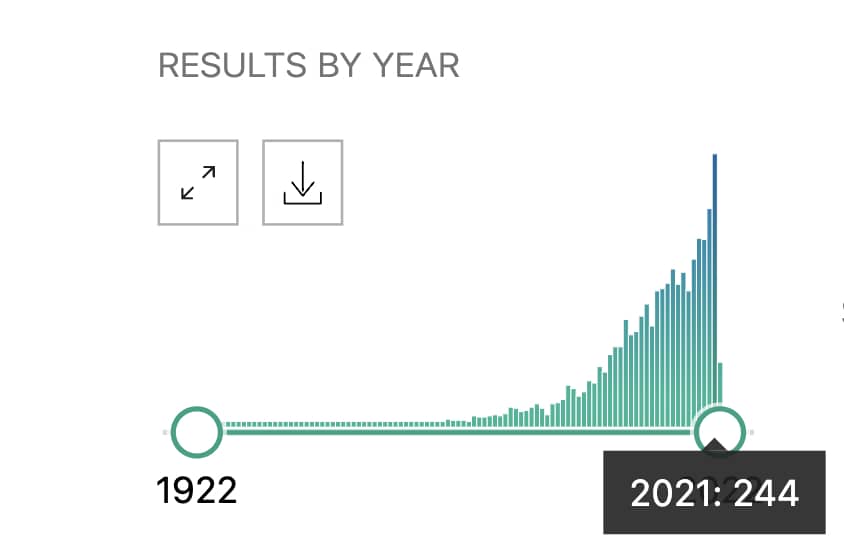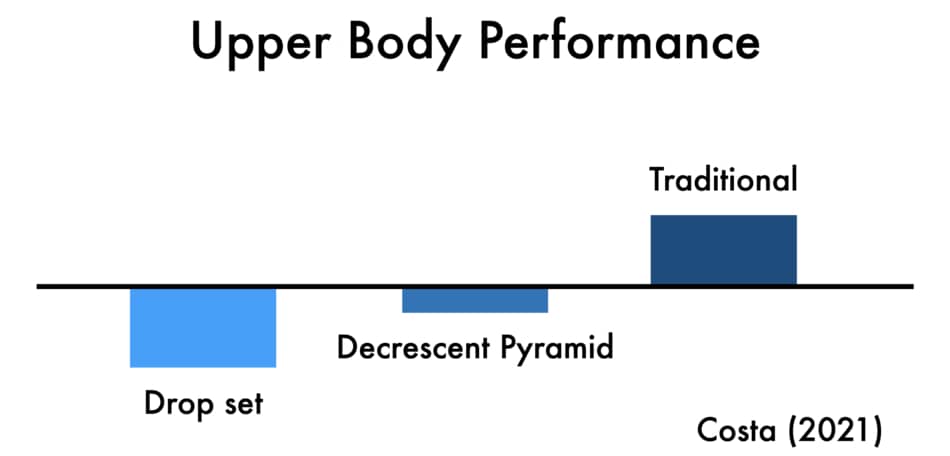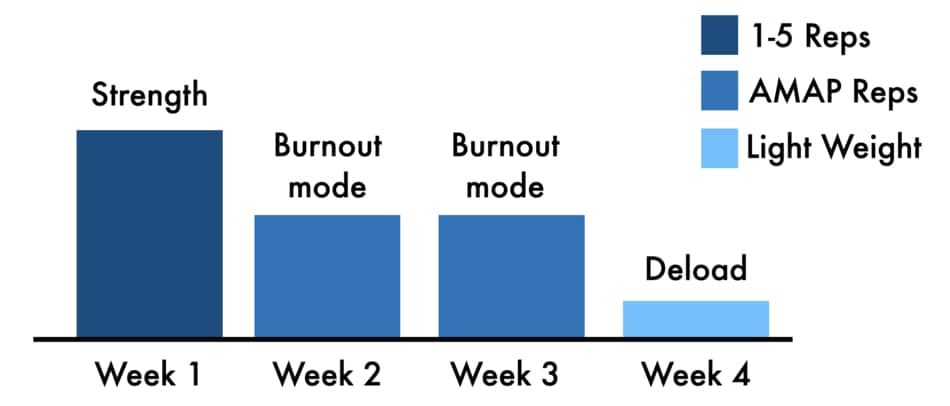Today I pull up the curtain and show you everything there is to know about Tonal burnout mode, and most importantly, how to implement it into your weekly training program.
As a whole, you can use the Tonal burnout mode as a part of the Tonal programs that focuses on Dynamic Modes, as well as during your Free Lift mode where you have more freedom of choosing your own exercises. However, because the burnout mode increases the lactate build-up, this training method should be used intermittently.

What Is Tonal Burnout Mode?
As a whole, the Tonal burnout mode is one of the five Tonal Dynamic Modes that helps to exhaust your muscles by extending time-under-tension. This training method is similar to the popular “drop set” “descending set”, or “strip set” that’s been around since the 50s.
The origin of drop sets comes from the Multiple Poundage System, which was a training program developed by the editor of Body Culture magazine, Henry J. Atkins in 1949. Since then, it was picked up and popularized by Joe Weider in his “Weider System” in the 80s.
In other words, burnout mode (as a training method) is nothing new. However, the Tonal gym has pioneered this type of training technique in a way that it automatically reduces the resistance for you, without having to change it manually (more on that later).
Is Tonal burnout mode based on science? In general, the Tonal burnout mode is based on science because the concept of drop sets has been studied for decades and has proven to be an effective way to increase muscle strength and hypertrophy. In fact, there have been over hundreds of studies done over the last couple of decades just on the drop sets alone.
See below.

This, of course, includes many angles and variations like the impact of drops sets and creatine on untrained people, the difference between drop sets and conventional sets on muscle growth, etc.
How Does Tonal Burnout Mode Work?
Overall, the Tonal burnout modes work by continuing to do the exercise with a lower weight, once a muscular failure has been achieved at a higher weight. Once the burnout mode is switched on, the Tonal gym algorithms automatically lower the weight for you so you can carry on with the movement and maintain time-under-tension.
What is muscular failure? In short, muscular failure is the point when muscles can no longer produce the necessary force to lift a weight due to fatigue. For example, doing a biceps curl until you can’t do it any longer.
What is time-under-tension? In general, the time under tension refers to the total time of which the muscle or muscle group is being active under the resistance of the weight. Higher time under tension has the potential for microtrauma and fatiguability across the full spectrum of muscle fibers.
Here’s how it works.
The key component of any training program that is designed to elicit hypertrophy and/or strength gains, consistently, is progressive overload. This means you need to challenge your muscles constantly overtime to avoid the plateau.
You can challenge the muscles by either adding more resistance (this is effective to stimulate hypertrophy in fast-twitch muscle fibers) or by increasing the number of repetitions (which helps in increasing time under tension and eliciting a hypertrophic response in slow-twitch muscle fibers).
The Tonal burnout mode allows you to recruit both slow-twitch and fast-twitch muscle fibers during the lift. Slow-twitch fibers work when you continue doing the lift with lower resistance, and fast-twitch muscle fibers work from the initial heavy weight lifts.
Whoah!
From the practical way, the Tonal gym has built-in sensors and accelerometers which can not only monitor your form but also senses that you struggle to complete the movement at the full range of motion (aka reaching muscle failure).
It also has power output meters that can tell exactly how many watts you put into every rep. Once the power output drops after a certain level, the burnout mode kicks in and lowers the resistance, so you can continue to do more reps.
NOTE: I want to remind you that the burnout mode is hard and it does not start right off the gate on your first rep. You must first reach muscle failure.
How Many Reps Can You Do On Tonal Burnout Mode?
As a whole, there are unlimited reps you can do on the Tonal burnout mode because the algorithms will continue to lower the weight until you stop the exercise. This means you can do up to 50 or even 100 reps, as long as you push yourself.
Here you can see an interesting video from Joey that demonstrates how to use Tonal burnout mode while doing 51 reps of a biceps curl.
As you can see, the Tonal burnout mode does not require you to change the pin to adjust the weight after each repetition.
Normally, if you would do drop sets in the gym you would have to set up your equipment in advance.
However, with burnout mode, you can not only forget about the manual weight adjustments but also get better results because you don’t have to “stop” the movement to lower the resistance.
Is Tonal Burnout Mode Effective?
In general, the Tonal burnout mode is effective because training to failure enhances exercise-induced metabolic stress, which is the primary mechanism of muscle hypertrophy. Plus, it also elicits a significant acute hormonal response in both testosterone and growth hormone.
What is metabolic stress? As a whole, metabolic stress is the buildup of metabolites (e.g lactate, phosphate inorganic, and hydrogen ions) in the muscle cell after prolonged exercise with minimum to no rest. Metabolites accumulation initiates anabolic signaling (muscle growth).
You can think of the metabolic stress as the “feel the burn” effect in your muscles that happen when you continue to lift low-to-moderate weight for more repetitions than usual.
- A recent studies have shown that “resistance training techniques like drop-set are commonly used by well-trained people for maximizing muscle hypertrophy and allow a greater training volume (i.e., total repetitions×load), due to the supposition that it elicits greater muscle mass gains” (Kassiano et al. 2021).
- Another studies from Dr. Julius Fink and Dr. Brad J Schoenfeld shown that “superior muscle gains might be achieved with a single set of drop set compared to 3 sets of conventional resistance trainnig, probably due to higher stress experienced in the drop set protocol” (Fink et al. 2018).
In other words, the burnout method is highly effective, however, it is not the optimal way to do resistance training for everyone.
Who Can Do Tonal Burount Mode?
Overall, the Tonal burnout mode can be done by everyone who is looking to build muscle. However, people who are interested in strength gains may find that burnout mode is less effective than conventional resistance training protocol.
Dr. Bruna Daniella de Vasconcelos Costa from the State University of Londrina in Brazil has documented eighteen trained male adults. The goal of this study was to compare strength performance for the upper and lower body from doing a burnout, decrescent pyramid, and traditional resistance training method.
See below.

As you can see, the results have shown that both drop set and decrescent pyramid training impaired the neuromuscular performance of the lower limbs (-6.7 and -1.9%, respectively). (Costa, 2021).
When it comes to strength performance for the upper body, only the only drop set group had a negative effect.
NOTE: Please note that the performance tests were done 30 minutes after the experimental sessions, on the same day.
Does this mean the Tonal burnout mode is ineffective? No.
This basically means that reaching muscle failure has a detrimental effect on performance without an adequate amount of rest.
In other words, people who like to train every day should avoid doing high-volume training on Tonal using only burnout mode because it can lower the overall performance and energy levels. However, if you train with enough rest you will be getting stronger.
How Often Can You Use Tonal Burnout Mode?
In general, you can do Tonal burnout mode 3 to 4 days a week with every exercise, however, this training method should be used intermittently with other techniques. For example, doing burnout mode for 4 weeks and moving on to something else can help to boost muscle gains but doing it for 3 to 6 months can backfire in the long term.
I like to use the Tonal burnout mode for two consecutive weeks where I focus more on building muscle endurance while recovering from heavy strength training week.
See the graph below.

As you can see above, the first week of my training usually starts with heavy lifts where I focus on building strength. For that, I use mainly compound movements like deadlifts, squats, bench, and overhead press with 1-5 rep range and keep the weight around 80-90% of 1RM.
In weeks two and three I use the Tonal burnout mode where I can focus on hypertrophy. For these two weeks, I also change the exercises. Instead of doing squats, I focus on leg extensions, and instead of doing a chest press, I focus on doing cable flyes.
In the last week, I recover by applying “deload” which is a way to reduce the intensity and enhance recovery. Week 5 starts again with strength, but with higher resistance than week 1.
Tonal Burnout Mode Free Lift
My favorite way to use the Tonal burnout mode is by using the free lift setup. This feature allows you to use the machine on your own, without the instructors. I can select any exercises of my choice and Tonal will guide me with lowering the weight.
Does Tonal burnout mode work on the free lift? As a whole, the Tonal burnout mode does work on the free lift feature, which is the option to do what you want to do. This feature gives you the freedom of using any exercise with as many reps and sets as you want.
Please keep in mind that I’ve been using the gym for most of my life, so I don’t have problems with choosing the right exercises for burnout mode.
HOWEVER.
For people who are beginners or who have a longer break, I strongly recommend trying some of the Tonal programs that are purely focused on the Dynamic Modes like burnout or eccentric.
Tonal Burnout Mode Programs
Tonal has several programs that implement burnout mode as the main focus of the training. These include:
- Divide and Conquer
- Muscle Building Burnout
- Burnout Challange
- Glutes + Inner Thigh Burnout
- Double Hit Burnout
- Lower Body Burnout
Also, please remember that some of the Tonal live classes and programs also use burnout mode. You can learn more about that in my article “tonal live classes” here.
Which Exercises Are Best For Burnout Mode On Tonal?
As a whole, the exercises that are best for burnout mode should elicit the greatest tension on a muscle at shorter muscle lengths to create the “pump” effect. These include:
- leg extension
- leg curl
- back extension
- barbell glute bridge
- lateral raise
- cable chest flyes
- bicep curls
- rope tricep extension
- pullover
On the other hand, you want to avoid doing compound exercises that maximize mechanical tension. Compound movements engage multiple muscle groups, which means you cannot create localized tension in just one specific muscle.
These include deadlifts, squats, hip thrusts, bench press, overhead press, chin-ups, and rowing. For those lifts, it’s better to add more resistance and lower the rep range.
Can You Use Tonal Without Burnout Mode?
Overall, you can use Tonal without burnout mode because the machine has many other useful features like spotter, eccentric, smart flex, or chains. In fact, people who are just getting started with lifting weights should start from conventional training methods before they progress to more advanced techniques.
You can learn more about “tonal eccentric mode” and how to use it in my article here.
Studies have documented that “doing drop sets induced greater motor unit activation and intramuscular hypoxia in people who have been regularly performing resistance exercises for more than one year” (Goto et al. 2016).
This means that beginners can have the same strength and muscle mass gains from doing either burnout mode or just regular lifting. The only difference is that the Tonal burnout mode will elicit higher metabolic accumulation, which leads to DOMS.
What is DOMS? In general, the DOMS is the acronym for delayed-onset muscle soreness, which is the muscle pain induced after prolonged physical activity. Using the Tonal burnout mode will likely develop a lot of muscular tension and can take days to recover.
That’s why I always recommend for beginners to start from regular lifts until they are ready to progress with their training program.
Conclusion
As you can see, the Tonal made a great job in the automation of the popular drop set training method. The burnout mode is a part of the Tonal Assistance Modes that helps to take it up a notch and continue with your progress.
One thing to keep in mind is that the Tonal burnout mode is not for everyone and it should not be done with all exercises.
